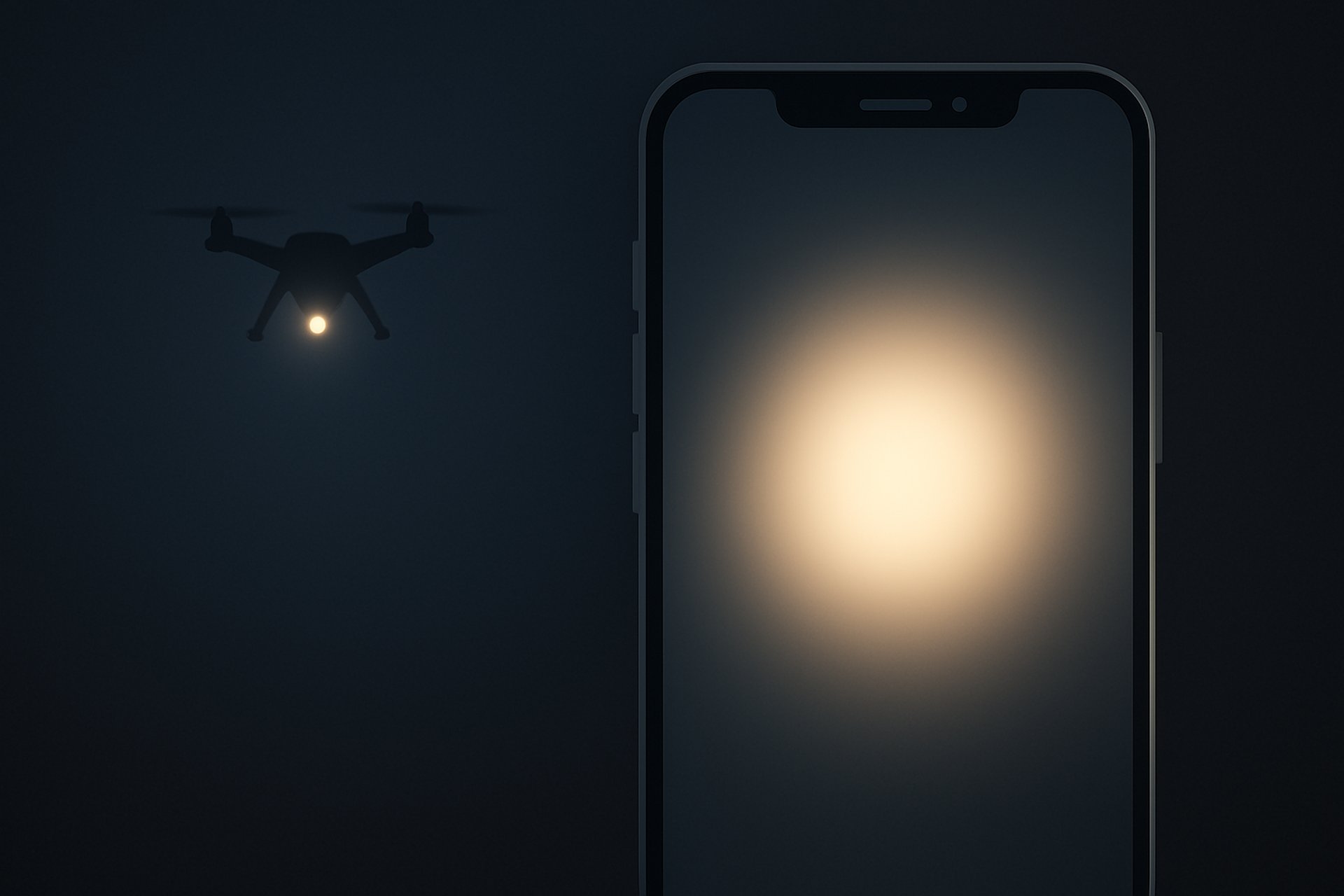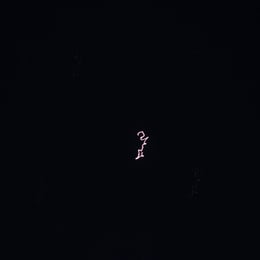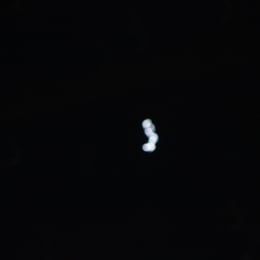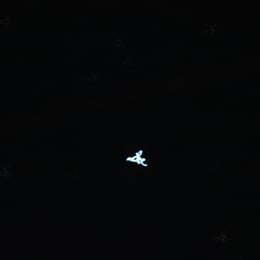Why Your Drone Footage Fails at Night — And How To Beat It
Infrared Jamming, Sensor Overload, and the Simple Trick That Changed Everything
DRONESEVIDENCECAPTURING VIDEO
Joe Fulmer
3/26/2025

Filming drones at night has always been tricky. Whether you’re using a high-end phone like the Samsung Galaxy S24 Ultra or a DSLR like the Canon T7, the result is often the same: fuzziness, distortion, or mysterious blue streaks across the footage. But after years of experimentation — and trying different tricks, one accidental breakthrough — I believe (fingers crossed) I have finally cracked the code!
🎥 My Setup: Samsung Galaxy S24 Ultra + Canon T7- A learning process...
Using the S24 Ultra in Pro Video mode, I frequently experienced a blue or purple spot when trying to capture drones in the sky at night. (Although better than my prior iPhone 11.) Sometimes the footage went completely fuzzy — and I wasn’t alone. On the iPhone video footage, you can easily see a pulse that causes a echoing image effect radiating from the drone. Any camera, same result. When I recently bought several lenses up to 800mm, the result was the same for my upgrade to a Canon T7. Normal usage, it is awesome the sharper pics and video. But, the result at night was equally strange: still just blue streaks or hazy blurs. No matter what I tried, clear footage remained just out of reach.
Until I stood under a brightly lit front porch, with my phone.
The difference was night and day. Suddenly, the camera picked up real detail. No more blue blobs, no more fuzz — the drone's body, shape, and flight pattern became visible, even with movement. So what changed?
🔧 The Problem: Drone Interference + Camera Sensor Limitations
Let’s break it down. Most consumer drones (and especially security or surveillance models) are equipped with technologies that make them hard to film — particularly at night.
🔴 1. Infrared Jamming (IR Floodlights)
Many drones emit infrared light (IR) that’s invisible to your eye but highly disruptive to cameras. These IR beams can overwhelm the sensor, blinding it with brightness the human eye doesn’t register. The result? Blue blobs, whiteouts, or full fuzziness on video.
💡 2. High-Intensity LEDs or Strobes
Drones may also use visible LED strobes that pulse in the dark. These sharp flashes can interfere with your shutter speed or sensor sensitivity, especially in a dark setting. That pulsating or flickering light can create unnatural streaks or distortions, as the camera tries to process limited light against a moving subject.
💥 3. Sensor Overload (Blooming & Flare)
Phone and DSLR sensors can become overwhelmed when a bright light source is isolated in a dark environment. This causes a phenomenon called blooming, where light spills into adjacent pixels — which creates haze, blur, or bright artifacts (like the blue streaks I saw on the Canon T7).
🕶️ 4. Stealth Coatings and Low-Reflective Design
Some drones use anti-reflective materials to avoid detection. These coatings don’t reflect IR or visible light well, making the drone harder to auto-focus on or capture in low-light conditions.
Camera Facts and Tips
Faster Shutter, Less Blur: Additional light also lets the camera use a faster shutter speed for each video frame (or a higher frame rate) without underexposing. That means moving objects freeze better. The drone’s motion will be crisper, not a streak, because the camera isn’t forced into long exposures to gather light. Reducing motion blur makes the subject look sharper. Combined with the reduction in noise, this immediately improves clarity in your footage.
Improved Auto-focus and Subject Visibility: With the porch lights on, there may be other objects illuminated in the camera’s field of view (trees, the house roof, the porch itself). This gives the auto-focus system reference points with contrast at various distances, making it easier to lock focus correctly (likely at infinity for the drone). Even if the drone is just a speck, the camera can more confidently focus when the overall scene isn’t just a void. Additionally, if the drone has any reflective surfaces, a bit of ambient light might catch it, making it slightly more visible against the sky. At the very least, the drone’s own lights will appear less dominating – they won’t bloom as much – because the camera is no longer straining in pure darkness. The lens flare artifacts from the drone’s lights can diminish when the exposure is balanced for a brighter scene (the relative contrast is lower), so the blue spot might disappear or be far fainter.
🌟 The Breakthrough: Bright Ambient Light Cancels the Attack
Here’s what changed everything for me:
I was standing on a brightly lit porch, holding my phone like usual, when I noticed the footage was suddenly clearer — dramatically so. At first, I didn’t connect the dots. I assumed the sudden change of environment when I had cut all the lights out had the drones move closer like they typically do anyway... But reviewing the footage later, I realized: no fuzz, no blue haze, no ghosting. Just visible drone movement. I only did a short/reel for a quick post before bed. I really wish I had videoed longer now.
💡 Why Light Works:
The bright porch light forces your camera to lower its ISO, resulting in less noise and clearer video.
The exposure shortens — meaning you get faster shutter speeds and less blur.
The drone’s IR and bright lights are now competing with your own ambient light — so they’re no longer able to blind or jam your sensor effectively.
Your auto-focus has more visible contrast, improving lock-on and reducing video hunting or mis-focus.
Essentially, you lower the drone’s ability to "overwhelm" your camera. You bring the camera back to balanced operation.
🎯 Tips for Capturing Drones More Clearly at Night
Here’s what I have learned will work and should work for you:
Stand under bright LED or similar lighted area--maybe flood lights. Bonus if they light up the trees or sky around you.
Use manual settings when possible. On the Canon T7 or S24 Ultra, control ISO, shutter speed, and white balance to prevent the camera from trying to "guess" in the dark.
Avoid pointing directly into drone lights. Focus near them instead.
Film from different angles. Move subtly to see if you can catch a better reflection or expose their movement pattern.
Look for heat-based flares. If you're still getting interference, try shooting with a basic IR filter attached or with a visible flashlight nearby to reduce saturation.
🧠 Final Thoughts: You’re Not Crazy — It’s Real Tech Interference
If you’re struggling to capture clear drone footage, it’s not you — and it’s not your gear. It’s likely that the drone is using countermeasures, whether passive (stealth) or active (IR jamming, strobe disruption). Cameras like the Canon T7, though powerful, don’t have the high-end sensor shielding or filtering needed to ignore those effects completely.
But the good news? You now have a simple, affordable countermeasure: ambient light. Light up your space, override the drone's interference, and regain control of the lens.
This discovery is going to shape everything I post from now on. It’s the moment I turned from just a watcher into a documentarian :). If you’re documenting harassment, surveillance, or flying tech near your home — this is your key.
📢 Coming soon: My night tests with filters, flashlights, and light diffusers.
📸 Also: Full side-by-side footage from Canon T7 in dark vs light conditions.
📬 Got footage or questions? Reach out — I want to feature real captures from the community.



JOEFULMER.COM
Copyright 2025. All rights reserved.
All content reflects my personal opinions, experiences, details, shared interactions, documents, and publicly available evidence. Disclaimer.
E: joe@joefulmer.com
C: 251.210.8636
Injured FedEx worker. Whistleblower. Surveillance target.
I’m exposing corporate abuse, drone harassment, and the truth they tried to bury.
🔗 gofundme.com/f/joefulmer
👁🗨️ @joefulmer on TikTok, YouTube, and X
💼 linkedin.com/in/joe-fulmer
🌐 joefulmer.com
